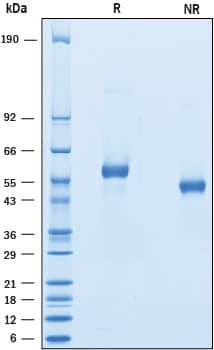Recombinant Cynomolgus LAG-3 His-tag Protein, CF
R&D Systems, part of Bio-Techne | Catalog # 9992-L3

Key Product Details
Product Specifications
Source
Chinese Hamster Ovary cell line, CHO-derived cynomolgus monkey LAG-3 protein
Val20-Leu450 (Pro 74), with a C-terminal 6-His tag
Val20-Leu450 (Pro 74), with a C-terminal 6-His tag
Purity
>95%, by SDS-PAGE visualized with Silver Staining and quantitative densitometry by Coomassie® Blue Staining.
Endotoxin Level
<0.10 EU per 1 μg of the protein by the LAL method.
N-terminal Sequence Analysis
Val20
Predicted Molecular Mass
47 kDa
SDS-PAGE
47-61 kDa, reducing conditions
Activity
Measured by its ability to induce TNF-alpha secretion by JAWSII mouse immature dendritic cells.
The ED50 for this effect is 0.15-0.9 μg/mL in the presence of a cross-linking antibody, Mouse Anti-polyHistidine Monoclonal Antibody (Catalog # MAB050R).
The ED50 for this effect is 0.15-0.9 μg/mL in the presence of a cross-linking antibody, Mouse Anti-polyHistidine Monoclonal Antibody (Catalog # MAB050R).
Scientific Data Images for Recombinant Cynomolgus LAG-3 His-tag Protein, CF
Recombinant Cynomolgus LAG-3 His-tag Protein Bioactivity
Recombinant Cynomolgus Monkey LAG-3 induces TNF-alpha secretion in JAWSII mouse immature dendritic cells. The ED50 for this effect is 0.15-0.9 µg/mL in the presence of a cross-linking antibody, Mouse Anti-His Tag Monoclonal Antibody (Catalog # MAB050R).Recombinant Cynomolgus LAG-3 His-tag Protein SDS-PAGE
2 μg/lane of Recombinant Cynomolgus Monkey LAG‑3 was resolved with SDS-PAGE under reducing (R) and non-reducing (NR) conditions and visualized by Coomassie Blue staining, showing bands at 45-61 kDa.Formulation, Preparation and Storage
9992-L3
| Formulation | Lyophilized from a 0.2 μm filtered solution in PBS. |
| Reconstitution | Reconstitute at 500 μg/mL in PBS. |
| Shipping | The product is shipped with polar packs. Upon receipt, store it immediately at the temperature recommended below. |
| Stability & Storage | Use a manual defrost freezer and avoid repeated freeze-thaw cycles.
|
Background: LAG-3
References
- Triebel, F. et al. (1990) J. Exp. Med. 171:1393.
- Baixeras, E. et al. (1992) J. Exp. Med 176:327.
- Workman, C.J. et al. (2004) J. Immunol. 172:5450.
- Huang, C.T. et al. (2004) Immunity 21:503.
- Workman, C.J. et al. (2009) J. Immunol. 182:1885.
- Li, N. et al. (2004) J. Immunol. 173:6806.
- Li, N. et al. (2007) EMBO J. 26:494.
- Andreae, S. et al. (2003) Blood 102:2130.
- Brignone, C. et al. (2007) J. Immunol. 179:4202.
- Brignone, C. et al. (2010) J. Transl. Med. 8:71.
- Woo, S.R. et al. (2011) Cancer Res. 72:917.
- Okazaki, T. et al. (2011) J. Exp. Med. 208:395.
- Bettini, M. et al. (2011) J. Immunol. 187:3493.
- Butler, N.S. et al. (2012) Nat. Immunol. 13:188.
- Durham N.M. et al. (2014) PLoS One. 9:e109080.
- Deng W.W. et al. (2016) Oncoimmunology. 5:e1239005
Long Name
Lymphocyte-activation Gene 3
Alternate Names
CD223, LAG3
Gene Symbol
LAG3
UniProt
Additional LAG-3 Products
Product Documents for Recombinant Cynomolgus LAG-3 His-tag Protein, CF
Product Specific Notices for Recombinant Cynomolgus LAG-3 His-tag Protein, CF
For research use only
